Deep inside the Sariska Tiger Reserve, a narrow road led us to the foothills of a mountain. There, it abruptly stopped, and we wondered how we were expected to go on. Our driver looked at me accusingly, surely blaming me for getting us all lost, in search of a temple he hadn’t heard of. Just then, a local on a bike appeared, hurtling out of nowhere. Seeing us, apparently lost, he stopped, and we asked for directions. He simply pointed to the mountain, and said the temple was up there. I was aghast, at the thought of climbing the mountain, in the heat. But then he pointed to a rough path ahead, and told us to follow it. We stared at the path, if we could call it that, in dismay. But having come this far, we didn’t want to return without trying our best. And by now, our driver had discovered his adventurous side. Metaphorically gearing up his loins, he got in, and assured us he could get us up the mountain. The next hour was a trial for our nerves, as the rocky path took us higher, and we bumped and swayed with every curve. Beautiful as the scenery was, all we could do was hold on tight. At last, we approached a gateway, and heaved a sigh of relief. There wasn’t a soul in sight, and we tried a few paths, all of which led us to dead ends, until, at last, we arrived at a clearing, and caught our first sight of the Neelkanth Mahadev Temple.
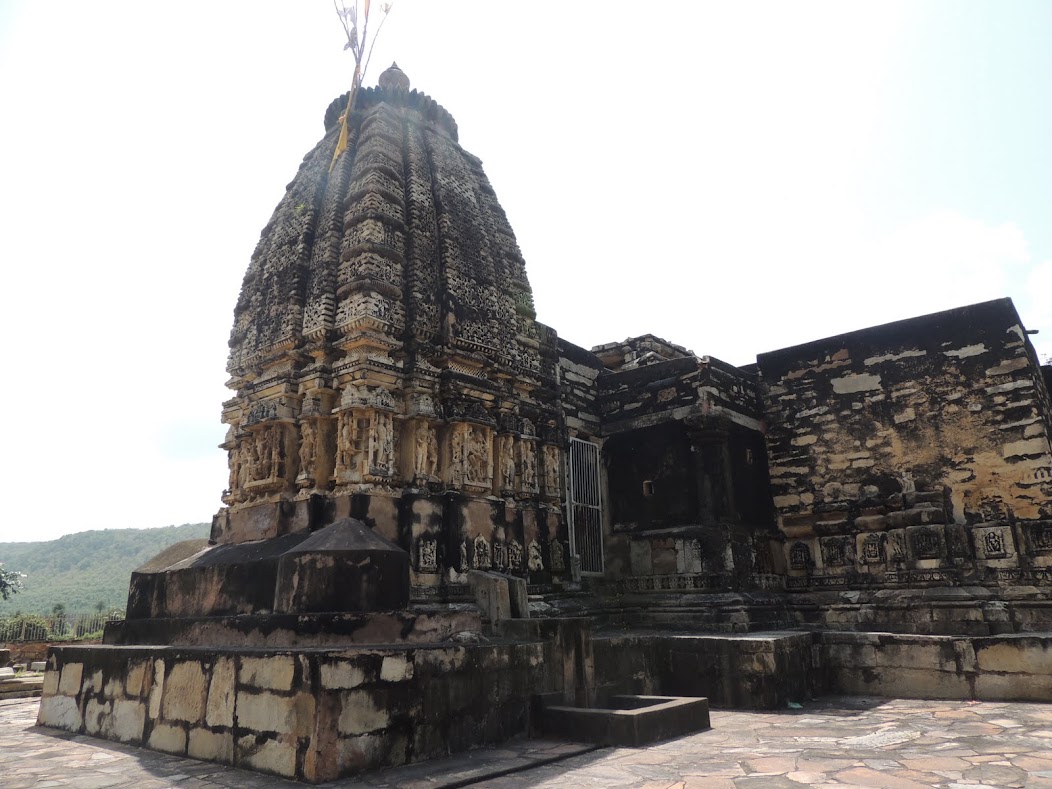
The Neelkanth Mahadev temple (according to the
ASI website) was built in the late 10
th century, by the king Mathanadeva, a feudatory of the Pratiharas. Interestingly, while the temple is named for Shiva as Neelakantha, the blue throated one who swallowed poison and saved the world, the temple has three shrines – the central one dedicated to Shiva, housing the aniconic Shiva linga, and two similarly sized shrines on either side, dedicated to Brahma and Vishnu. Sadly, both these shrines are locked up, since they are partly ruined, and the idols are broken. However, the doorways, which are still intact, suggest that the temple was built to worship all three deities.
 |
| The lintel of the main sanctum. Brahma, on the left, then Ganesha, Shiva as Nataraja in the centre, then Chamunda, and Vishnu on extreme right. The two figures on the sides are Matrikas. There are 6 of them in all on the two sides, similar to the temples at Kiradu. |
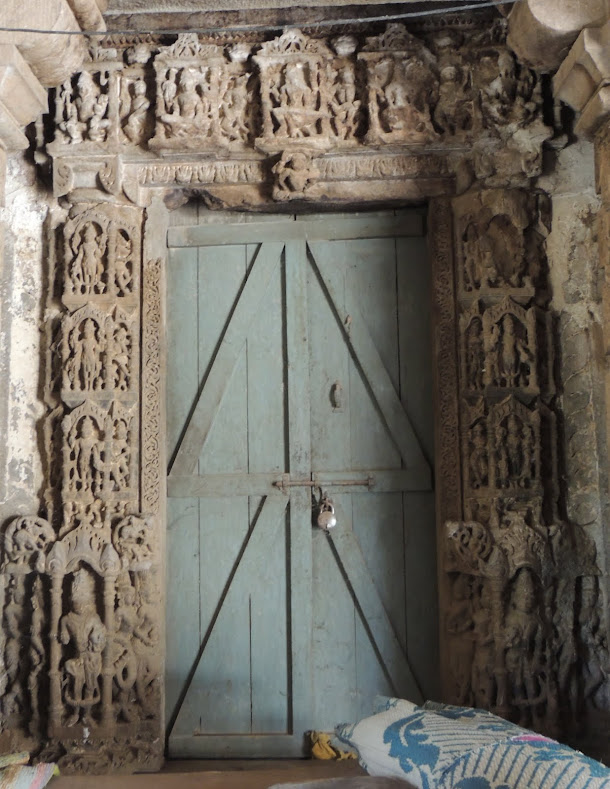 |
| Doorway of the Vishnu Shrine. The pillars and the lintel have figures representing different forms of Vishnu |
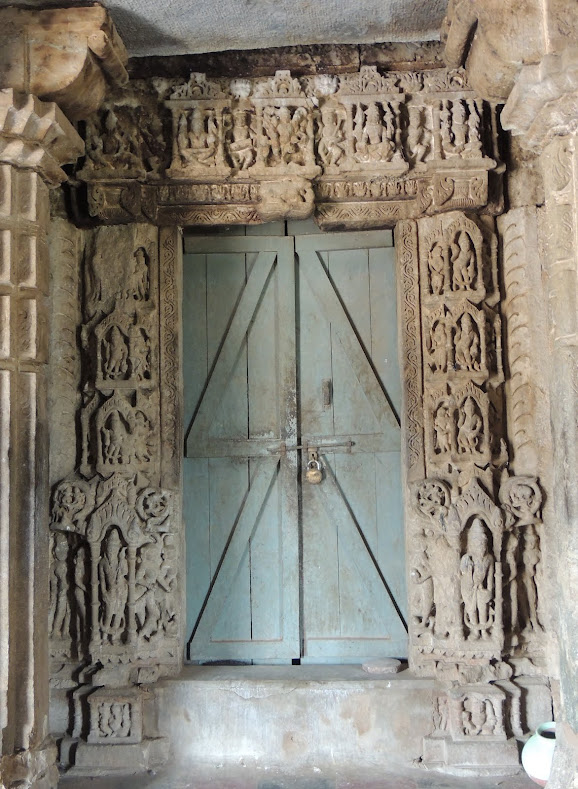 |
| Doorway of the Brahma Shrine. The pillars and lintel have figures of sages. |
The three shrines share a common Rangamandapa, which is preceded by a porch. The pillars as well as the ceiling are elaborately decorated.
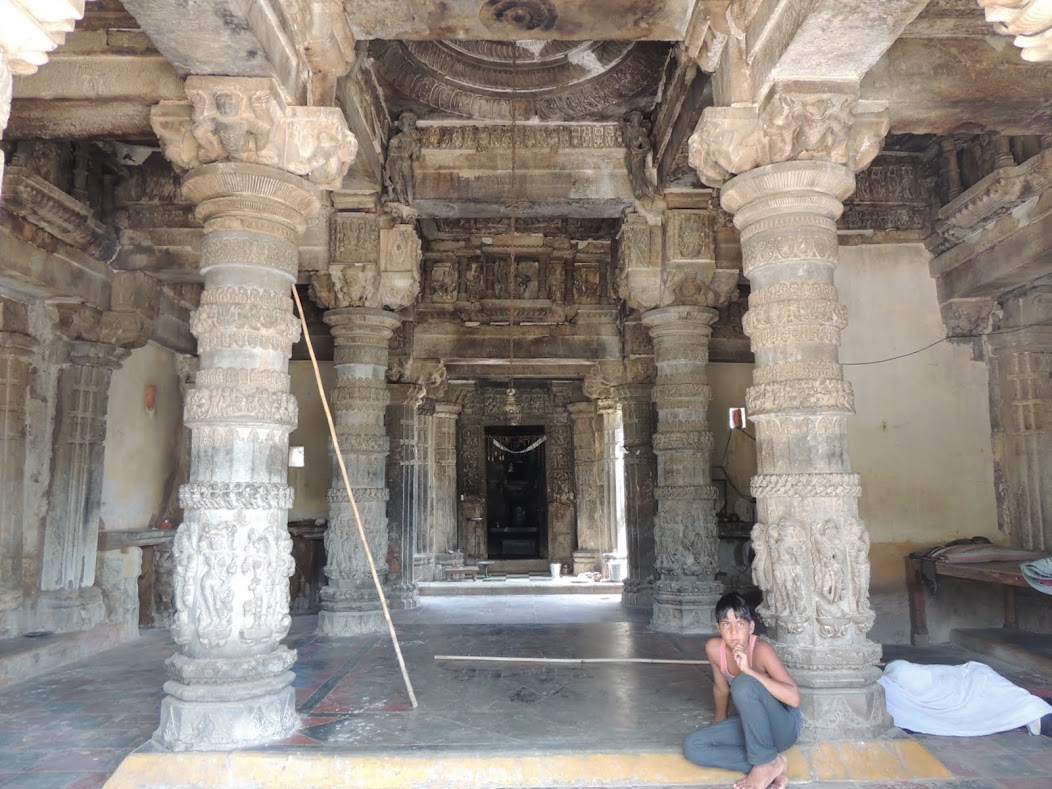 |
| A view of the temple from the entrance. You can just see the entrance to the two other shrines on the extreme left and right. |
 |
| One of the pillars of the outer porch |
 |
| The second pillar of the porch. Notice the carving of Surasundaris, above them the Vidyadharas, and above them the Kirtimukhas. These pillars reminded me of the temples of Kiradu, especially the octagonal hall in the Vishnu temple. Read about it here. |
Most beautiful, however, are the Surasundaris, or celestial women, shown on the decorative brackets holding up the ceiling. Their stance is reminiscent of the Shalabhanjikas, whom we usually associate with Buddhist structures.
 |
| Two of the Shalabhanjika-like Surasundaris on the brackets. There are two more on the other side. |
The temple is built on an elevated platform, and on the base, as well as the outer walls of the temple, are a number of sculptures, of deities....
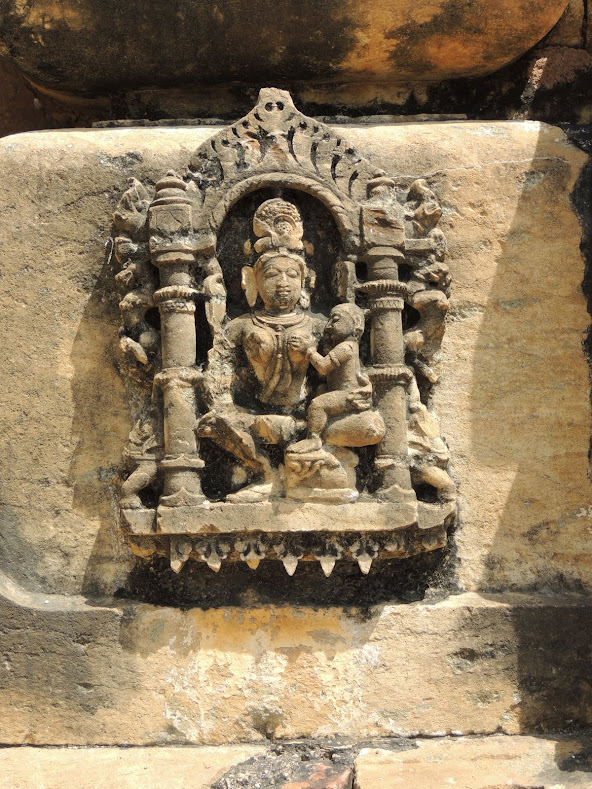 |
| Ambika or Matrika? |
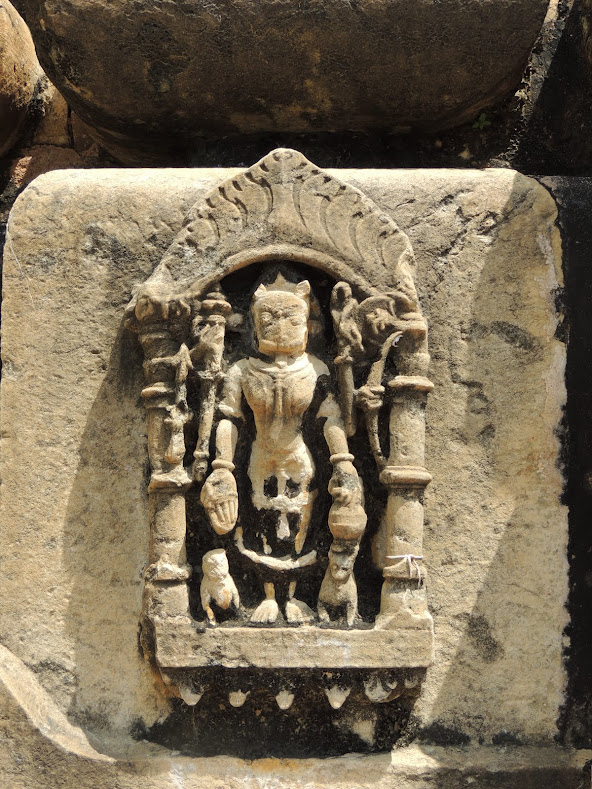 |
| A very interesting, standing Narasimha, shown with the attributes of Vishnu, holding, among other things, a Kamandalu in his hand. Though he is shown with his tongue hanging out, he seems to be a calm and meditative figure, quite unlike usual depictions of Narasimha. Update: As someone pointed out on Instagram, this is more likely to be Narasimhi. |
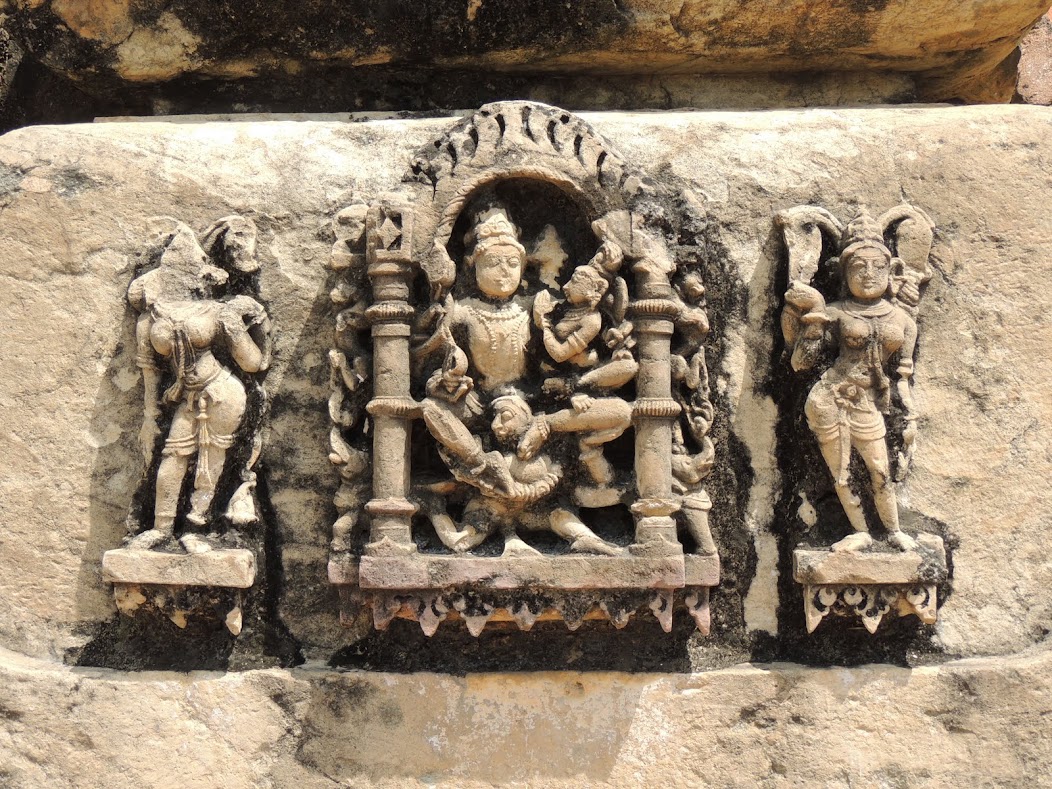 |
| Vishnu and Lakshmi on Garuda, flanked by two attendants. Its a beautiful depiction, and one of the few which is so clear |
Ashta Dikpalas, the guardians of the eight directions…
 |
| Vayu, seen on the Northern wall |
Apsaras / Surasundaris, or celestial women…
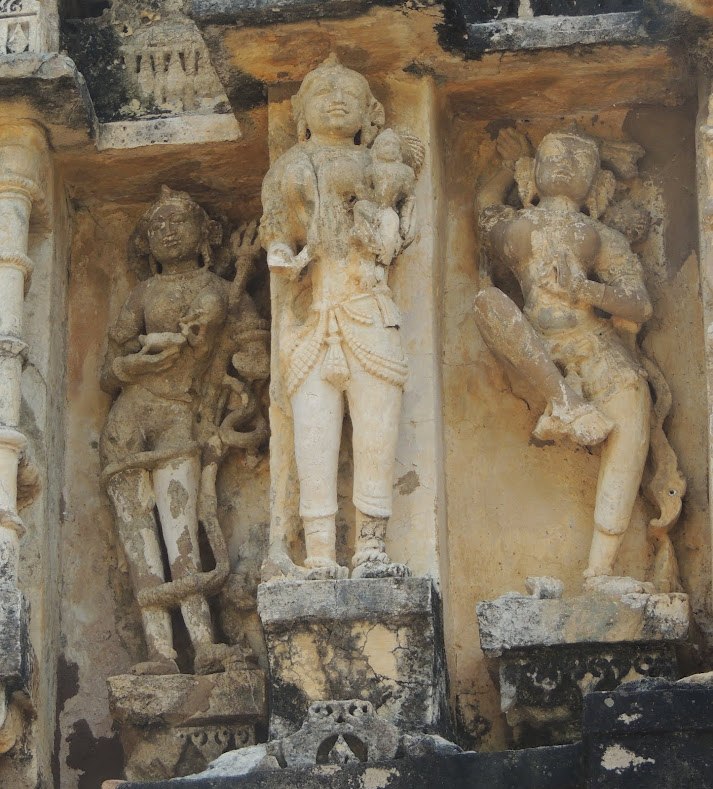 |
| The central figure and the one on the right are Surasundaris, one holding a child, and the other dancing. The figure on the left is an interesting one, shown naked, and with a Trishul and cup. |
Vyalas or mythical creatures, and Mithunas or couples.
 |
| The northern wall of the temple, showing the series of figures at both levels. Notice the mythical creatures alternating with the couples in the recesses |
In the main niches around the central shrine are
Narasimha in the North, shown here tearing into Hiranyakasipu with his bare hands, while Prahalada looks on….
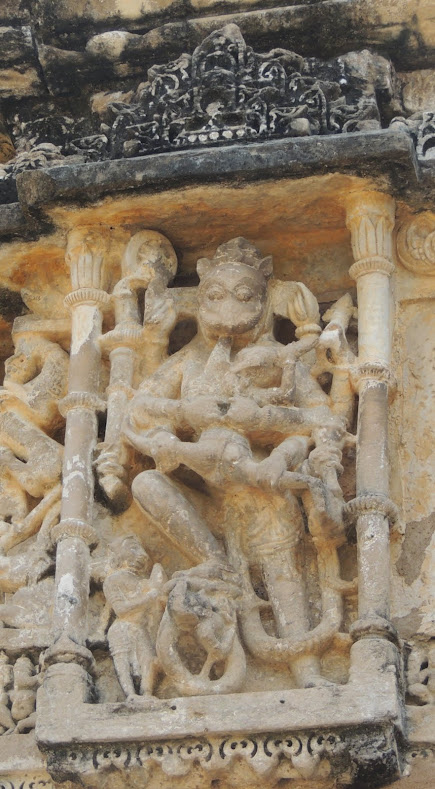 |
| Narasimha, the fourth avatar of Vishnu |
Tripurantaka in the South, his many hands filled with weapons, the bow aimed to shoot the arrow, towards the three cities of the Asuras…
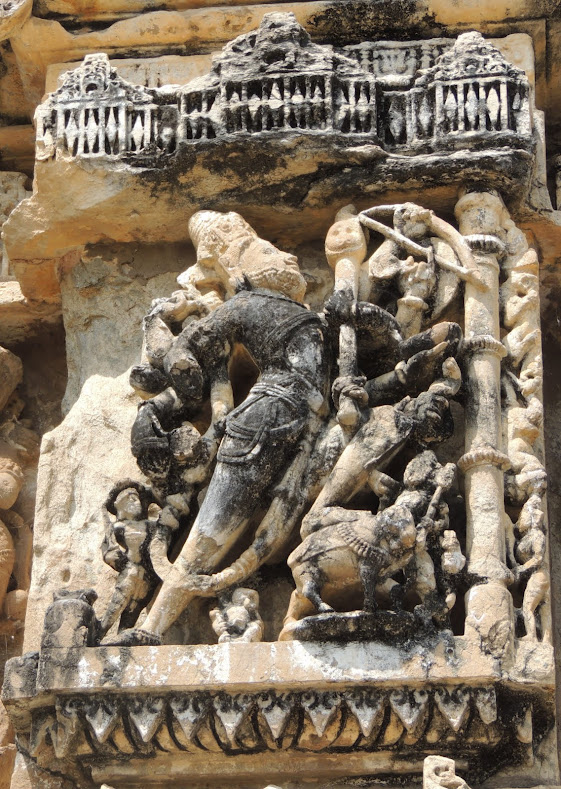 |
| Tripurantaka, the form of Shiva where he destroys the three cities of the asuras |
And a gorgeous composite figure in the East.
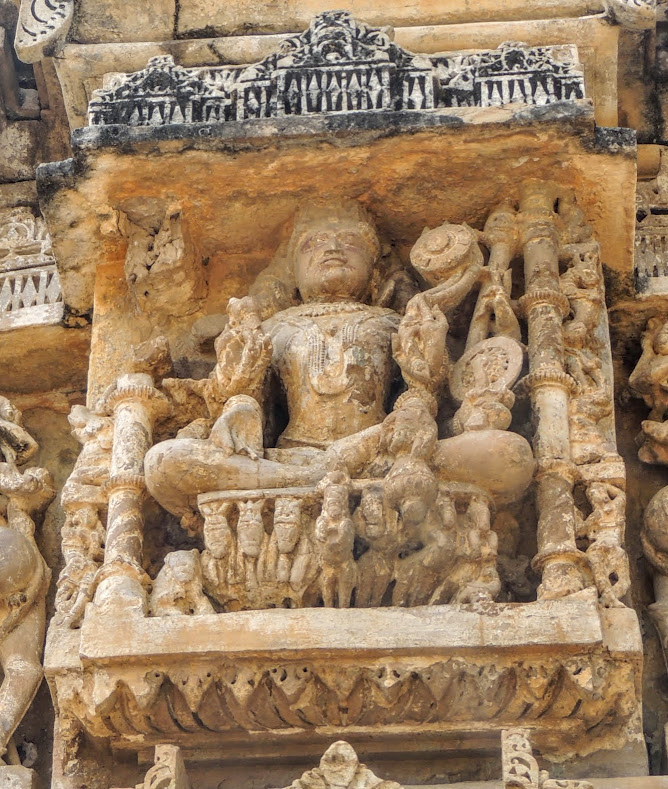 |
| Hari-Hara-Arka or Hari-Hara-Pitamaha-Arka? |
The ASI identifies this figure as Hari-Hara-Arka – a composite form of Vishnu, Shiva and Surya. However, considering the placement of the figure (facing east), the presence of the Brahma and Vishnu shrines in the temple, and the Kamandalu he holds in one of his hands, I think this could be Hari-Hara-Pitamaha-Arka, a composite form of Vishnu, Shiva, Brahma and Surya, seen in many other temples of the period, including ones at Khajuraho, Kiradu, as well as Ambernath.
There are two smaller structures behind and on either side of the temple. Only the bases of these structures survive, and since there is no information at all, I have no idea whether these were bases of other temples, or associated with some sort of rituals. The stones which make up these structures have figures carved on them, of deities, both, male as well as female, and also erotic sculptures. Unfortunately, the figures are extremely worn, and it was difficult to identify them with any certainty.
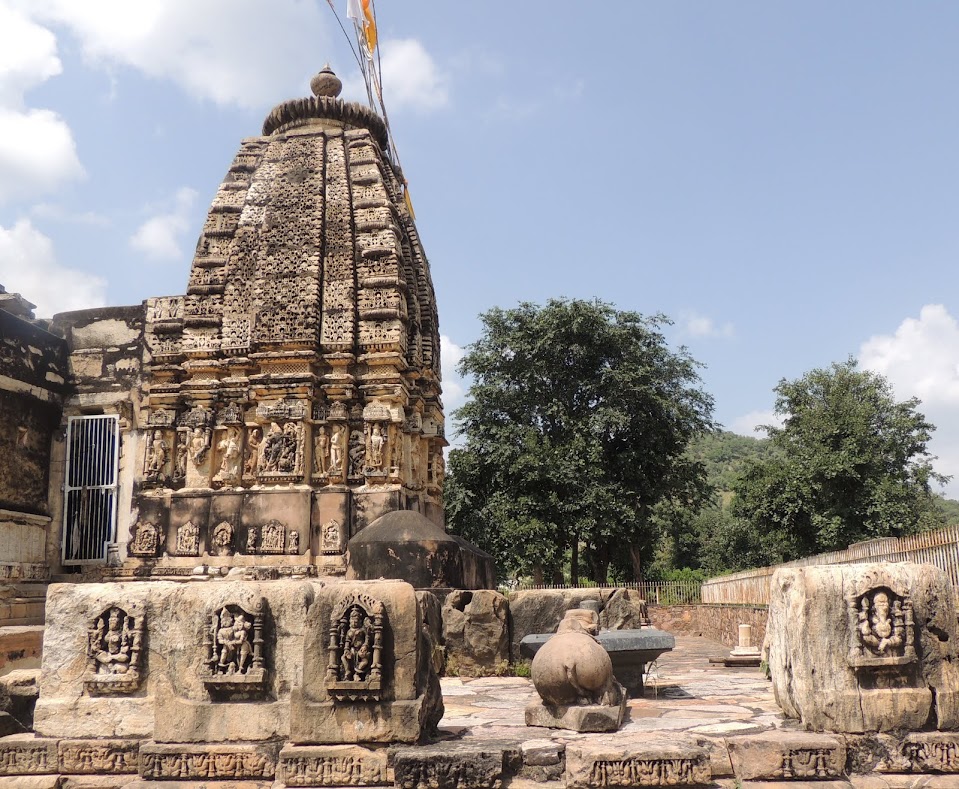 |
| A view of the smaller structure behind the temple. A Shiva Lingam and Nandi have been placed here, though they are not fixed. The low flooring with the placement of carved stones around suggests a space for rituals |
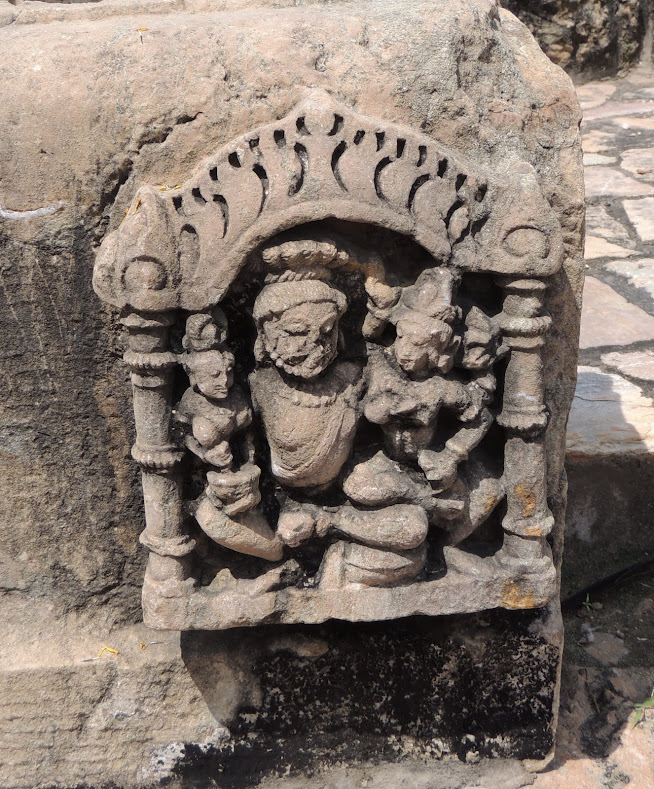 |
| A male figure with beard and two women. The one on the right could be a consort, and the other an attendant |
 |
| Durga? seated on tiger? |
The sculptures on the walls of the temple are just a fraction of what must have originally stood here. There are sculptures strewn all around, and the slightly better ones are placed under lock and key in two sheds on the sides of the temple. I wished I could go in and look at them, but they are out of bounds to visitors.
 |
| One of the sheds storing the sculptures |
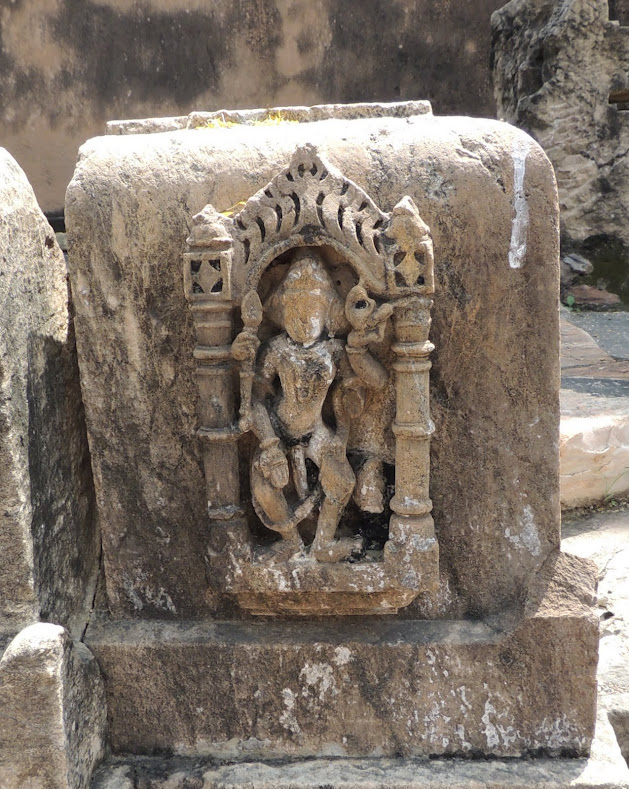 |
| Loose sculpture of Kartikeya. Notice the three heads, the spear in his left hand and the rooster in the right hand. The peacock, interestingly, is missing. |
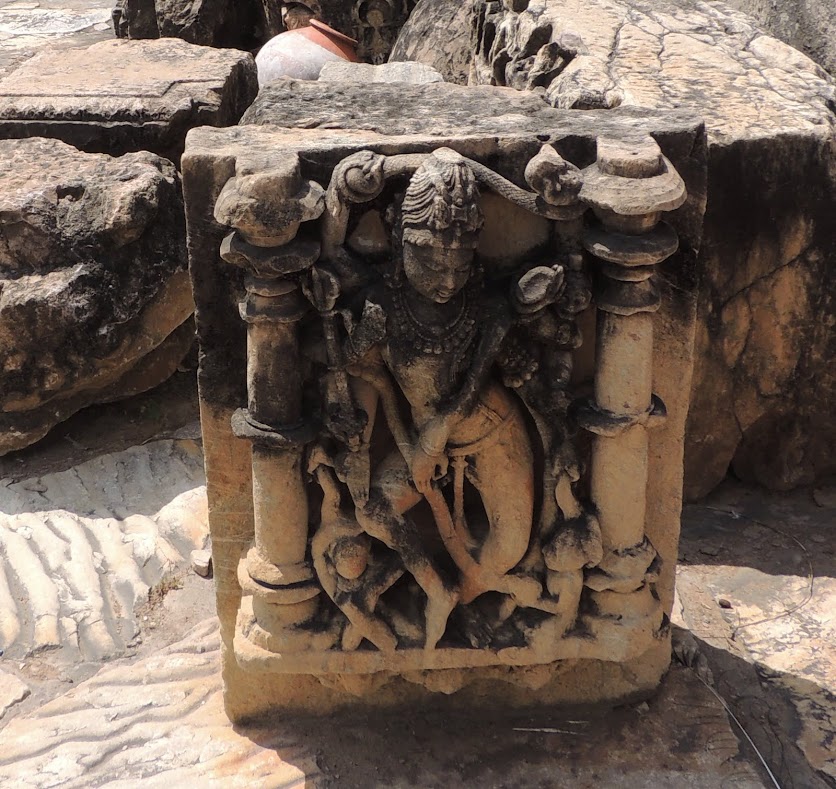 |
| Loose sculpture of a beautiful Natesa. just lying around |
There was no official from the ASI when we visited, though this is a protected site. In fact, there was no one around, but a young boy about Samhith’s age, the son of the priest who conducted the prayers here. They lived in a nearby village, and his father was out for the day, so the boy was on duty instead. Samhith took one look around, and decided that the peacocks outside were far more interesting. Shankar, on the other hand, decided that the intact Shiva Linga in the sanctum merited prayers, despite the absence of the priest. He managed to befriend the young boy, who led him to a tap nearby to get water, and then watched while Shankar bathed the lingam, chanting the Rudram. Meanwhile, I walked around, ruing the state of the sculptures and the utter lack of maintenance.
Interestingly, just 100m from the temple is a colossal statue of the Jain Tirthankar Shantinath. Sadly, however, there was no board to inform us where exactly it was, and we couldn’t see it from where we stood. Besides, our driver was getting restive. It was late, and he had to drive down the rickety, rock covered path. We finally gave in, and decided to call it a day.
Each of us had enjoyed the experience – while Samhith was thrilled with the peacock feathers he had found strewn all over, Shankar was quietly pleased with the experience of bathing the Shiva Lingam in this ancient temple with his own hands. As for me, there was a sense of satisfaction, in visiting a temple I had yearned to see, since I first read about it. It was certainly worth every minute of the gruelling ride of the worst road I have ever been on!
Information:
- Location: The Neelkanth Mahadev Temple is located in the Alwar district of Rajasthan, within the Sariska Tiger Reserve. It is about 70 Km from Alwar, and 120 Km from Jaipur.
- How to Reach: It is advisable to hire a car, preferably one which can navigate bad roads, from either Jaipur or Alwar.
- Where to stay: You can choose to stay at either Jaipur or Alwar, and make a day trip.
- Suggestions
- If you are driving from Jaipur, you can also combine Neelkanth with either Bhangarh or Abhaneri.
Ensure you keep ample time for the temple, since the drive takes up a lot of time. Try to arrive early in the day, to avoid the heat. Besides, you have a better chance of meeting villagers enroute who can direct you to the temple, as well as the statue of the Jain Tirthankar.
P.S. To see more photos of the Neelkanth Mahadev Temple, click here.
Interesting post!!
ReplyDeleteLove the sculptures on the walls of the temple. People in the past really had very good taste in art. Looking at those stone crafts really like enjoying miracles.
Wow, Beautiful temple complex. Nice that temple have survived to show us its beauty . Thanks for showing us around.
ReplyDeleteBeautiful sculptures. Awesome temple. Thank- You for sharing this informative blog with us.
ReplyDeleteIt looks truly amazing! I cannot even imagine doing something so majestic, and to do it without current technology is even more impressive... Cheers!
ReplyDeleteNice Post...
ReplyDeleteWOW! what a beautiful temple it is. the temple is truly majestic in all the ways and you surely have captured some of the most amazing pictures. thanks for sharing the blog. Loved it.
ReplyDeletenice photos with detail story
ReplyDeleteThese are the real hidden treasures. This place looking awesome and phenomenal. The ancient architecture of this place is fantastic. These stunning pictures are the proof for it.
ReplyDeleteVery Nice Blog
ReplyDelete